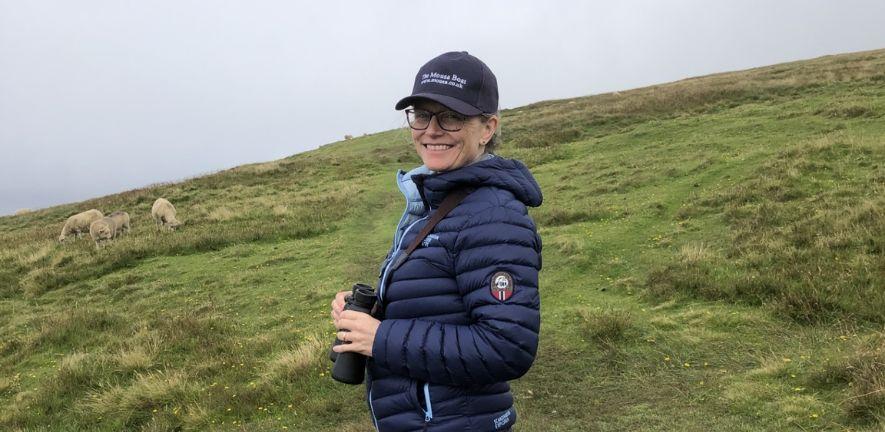
To celebrate International Women's Day this year we interviewed Professor Lynn Dicks, Co-Chair of Global Food Security IRC.
Professor Dicks is Professor of Ecology in the Department of Zoology at the University of Cambridge, where she leads the Agroecology Group. A conservation scientist focused on biodiversity in agricultural landscapes, she started out as an insect ecologist studying the community ecology of flower-visiting insects and the pollination of wild plants in the context of hay meadow restoration.
She told us about choosing a life in academia, an amazing natural treasure hidden in plain sight, and why scientific research should be accessible to all.
Please tell us about your research.
Since starting out as an insect ecologist, I’ve been fascinated by the wild species that manage to live alongside humans, in heavily degraded farmed or urban landscapes.
I strongly believe we need to care for this nature as much as we care for the rare special species that live in remote wild places. This is partly because these common species provide ecological functions that contribute value to our economy and society – think of at least 5% of all the world’s food production depending directly on pollinators. It’s also because this is the nature that most people connect with in their daily lives.
My research focuses on how to protect and manage biodiversity within agricultural landscapes, alongside sustainable, high-yielding food production.
I am deeply committed to getting science used in policy and practice, and I spend considerable time and energy working with policymakers and farmers to exchange knowledge and help embed scientific evidence in decision making.
What’s the most significant professional choice you’ve had to make?
There was a bifurcation point in my career. After my PhD I stayed at home with young kids for seven years. During that time, I was self-employed part-time as a science writer and broadcaster. I loved the work. When my youngest child started pre-school, I began applying for jobs.
I was offered a full-time position as a science editor on a major international magazine, working in London, at the same time as being offered a post-doc position back in University. I chose research over journalism. The journey from there to the academic faculty position I have now has been arduous and very insecure at times, but in retrospect it was definitely the right direction for me.
What was the most recent paper you published, and how did it come about?
My latest accepted paper is led by the amazing postdoc Katherine Berthon, who has been managing a large-scale experiment across two UK landscapes on the effects of a transition to regenerative agriculture.
The paper describes two different approaches to studying actual real-world outcomes of this complex and farmer-led change in agricultural system. The big question – is regenerative agriculture more ‘sustainable’? Does it deliver on climate, biodiversity and food production goals, as promised by many who are practicing and preaching it with great vigour? We are working at farm-scale, whilst a partner project has a demonstration field trial that stacks different practices experimentally.
Both projects are part of a large research programme called ‘Transforming UK Food Systems’. It was great to have a chance to come together to write this thoughtful piece on how scientists are working together with farmers to gather decent empirical evidence, and how two approaches at different scales perfectly complement each other.
Who or what inspires you?
I am inspired by nature, especially the small unsung, largely unknown creatures that live out complex and fascinating lives in all corners of this wonderful Earth. Sometimes they’re right under our noses.
On the urban ecology field course this year, one of the Ecology and Conservation students found a population of striated earthstars living under the trees on Coe Fen, right in the middle of Cambridge. These were not a group of funguses I had previously known – they are weird. Like beaked puffballs caught inside gigantic open beech nuts, just sitting there on the ground, with people walking past all the time.
I find nature often offers up such treats when you choose to look closely. How could you not be inspired?
Picture: One of the striated Earthstars (Geastrum striatum) discovered on the urban ecology field course. Credit: Rob Tingle
Have you ever had a ‘eureka’ moment?
I’ve had one eureka moment, back in 2001, when I was doing my PhD and pregnant with my second child. I remember it as clear as day, because I almost didn’t continue in science as a result.
I had compiled the field data to build comprehensive ecological networks of flowering plants and their flower visitors in hay meadows, over two very intensive summers. ‘Plant pollinator networks’ were a new thing at the time. Only one had ever been published, and no-one had analysed them to look for community structures commonly found in food webs, such as compartments.
I discovered a way to do this and then realised that in mutualistic interactions between flowers and their pollinators, subsections or compartments should reflect classic ‘pollination syndromes’. I remember being extremely excited about this, but then finding it almost impossible to explain to friends and family what it was, or why I was excited.
What is the point of research, I thought, if I can’t even explain why it matters to the people I love?
This experience has coloured my thinking ever since. It is the reason why my approach to science is very applied. I always try to work in partnership with non-academics to answer real practical questions in farming and nature conservation. The paper, ‘Compartmentalization in plant-insect flower visitor webs’, was published in 2002 and is still being cited.
Do you have a favourite place in Cambridge?
I have a passion for libraries. I first thought of the main Cambridge University Library, with its awesome galleries, staircases and reading rooms, and secret upper floors. I spent a lot of time in South Front 5 as a PhD student, sitting at a window looking out over Clare College. The Zoology library, with its mega-bay window, portraits of past Heads of Department and very distinctive smell.
Then I remembered the Central Science Library, which is sadly no longer with us. I loved that place. The green and white tiled floors in the hallway, the grand but understated staircase that led up to it, and then once in there, this incredibly secret, splendid room, holding all the scientific knowledge from the past hundred years or so. It had a magnificent arched ceiling of windows and narrow balconies on both sides, reached by spiral staircases at either end. I spent days in there never with many other people and often alone. I miss it.
Picture: The former Central Science Library in Cambridge.




